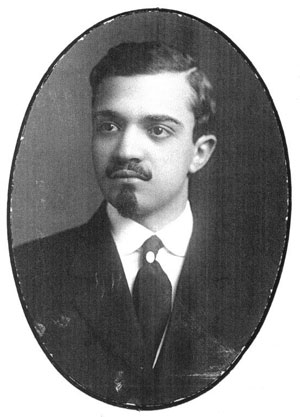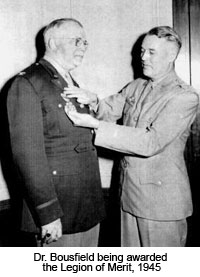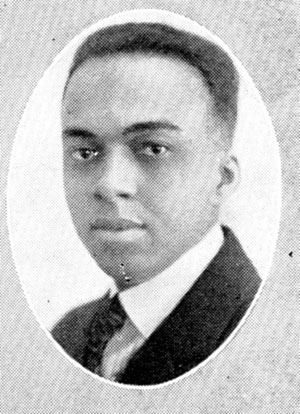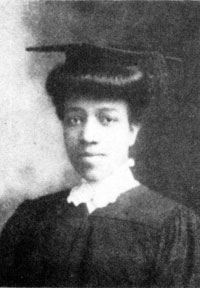By: Ron Sims, Special Collections Librarian (now retired)
This is the fourth annual article featuring African American graduates during Black History Month. It's a great pleasure to discover and present brief narrations of the lives of those who have influenced and enriched our culture.
Midian Othello Bousfield
 Midian Othello Bousfield was born in Tipton, Missouri on August 22, 1885. His father, Willard Hayman Bousfield, was a barber and businessman who set the stage for his son’s interest in business. Dr. Bousfield was also inspired by W. E. B. DuBois’ social agenda for education and activism in the African American community. Awarded a bachelor degree from the University of Kansas in 1907, Dr. Bousfield completed his medical studies at Northwestern University Medical School in 1909. His formal medical education concluded in 1910, with an internship at the Freedmen’s Hospital in Washington D.C.
Midian Othello Bousfield was born in Tipton, Missouri on August 22, 1885. His father, Willard Hayman Bousfield, was a barber and businessman who set the stage for his son’s interest in business. Dr. Bousfield was also inspired by W. E. B. DuBois’ social agenda for education and activism in the African American community. Awarded a bachelor degree from the University of Kansas in 1907, Dr. Bousfield completed his medical studies at Northwestern University Medical School in 1909. His formal medical education concluded in 1910, with an internship at the Freedmen’s Hospital in Washington D.C.
In 1911, he traveled to Brazil to seek his fortune, contemplating the possibility of opening a medical practice and even prospecting for gold! This adventure did not pan out as planned and he returned to Kansas City in 1912, where he was a visiting physician at the City General Hospital and maintained a private practice. He returned to Chicago in 1914 with his new bride, Maudelle Tanner Brown.
From 1915 to1919, Dr. Bousfield was employed as secretary of the Railway Men's International Benevolent Industrial Association, an African American railroad union. During this time, he also served as a Chicago Public School health officer, school tuberculosis physician and maintained a private practice. In 1919, he became one of the original incorporators of the Liberty Life Insurance Company and began this new business opportunity as medical director and vice president. In 1929, he facilitated a merger of Liberty Life and two other black insurance companies, Supreme Life of Columbus, Ohio and Northeastern Life of Newark, New Jersey, reorganized as the Supreme Liberty Life Insurance Company, with headquarters in Chicago.
He was president of the National Medical Association in 1934-1935.
From 1934 to 1942 Dr. Bousfield was associated with the Julius Rosenwald Fund and was appointed Director of Negro Health. Through his experience as a physician and businessman he became focused on the need to improve health care for the underserved African American population in the South and to improve African American hospitals, create medical education programs for nurses, physicians, public health officers and obtain funding to aid African-Americans in post-doctoral education. Most notable during this time he was influential in establishing an infantile paralysis unit at the Tuskegee Institute and at Provident Hospital in Chicago.
 He was the first African American speaker at the meeting of the American Public Health Association in 1934. His speech was published in Association’s journal.* He frankly stated in his speech that health officials “so complacently review, year after year, the unfavorable vital statistical reports of one-tenth of the population and make no special effort to correct them.” Bousfield attributed this lack of action to racist blinders. As a result the Association and its membership became more mindful, as never before had such a direct and clear view of neglected African American health care been presented to the Association. In 1936, Dr. Bousfield was elected president of the Chicago Urban League. In 1939, he was appointed to the Chicago School Board, the first African American to hold that position.
He was the first African American speaker at the meeting of the American Public Health Association in 1934. His speech was published in Association’s journal.* He frankly stated in his speech that health officials “so complacently review, year after year, the unfavorable vital statistical reports of one-tenth of the population and make no special effort to correct them.” Bousfield attributed this lack of action to racist blinders. As a result the Association and its membership became more mindful, as never before had such a direct and clear view of neglected African American health care been presented to the Association. In 1936, Dr. Bousfield was elected president of the Chicago Urban League. In 1939, he was appointed to the Chicago School Board, the first African American to hold that position.
During World War II, Dr. Bousfield commanded the first African American army hospital, located at Fort Huachuca, Arizona. His appointment prompted the National Medical Association to officially censure its former president for contributing to the continuance of segregation. Bousfield, the first African American colonel in the Army Medical Corps, countered that the hospital provided African American physicians with unprecedented professional opportunities.
In 1945, after a difficult tenure at the hospital, he retired from the military and returned to Chicago. In 1946, he was instrumental in organizing the Provident Medical Association, an organization of prominent and progressive African American physicians in Chicago who supported and funded medical specialists education. He died of a heart attack on February 16, 1948, and was survived by his wife Maudelle, the first African American high school principal in Chicago.
* “Reaching the Negro Community.” Am J Public Health Nations Health. 1934 March; 24(3): 209–215.
Edward Willingham Beasley
 Edward Willingham Beasley was born in Macon, Georgia on May 9, 1898. As a young boy he met Dr. Richard Carey, an otolaryngologist and the first African American specialist in Macon. From this association he was inspired to become a physician and a specialist.
Edward Willingham Beasley was born in Macon, Georgia on May 9, 1898. As a young boy he met Dr. Richard Carey, an otolaryngologist and the first African American specialist in Macon. From this association he was inspired to become a physician and a specialist.
Dr. Beasley's parents were not wealthy, but they knew the value of education. His father had had a taste of an academic education at Atlanta University and his mother had studied at Fisk University in Nashville, Tennessee. Dr. Beasley’s courses were pre-medical at Fisk beginning in 1914, and after graduation in 1918, he entered Northwestern University Medical School. As a fourth year medical student he was able to secure a position with the Chicago Health Department as a bacteriologist. His hours were six until midnight, with medical school during the day.
Despite the many nights of two hours or less sleep, he maintained a high scholastic record. A series of fortunate circumstances plus his own ability directed him on a route to pediatrics. On the recommendation of chief nurse Florence Olmstead of the Montgomery Ward Clinics at Northwestern, he was introduced to Dr. Isaac Abt, Professor of Pediatrics, and within several months, Dr. Beasley became Dr. Abt’s clinical assistant. In 1922, he had qualified, through a competitive examination, for a coveted intern position at Cook County Hospital. Upon completion of the internship, he was awarded an MD from Northwestern University in 1923.
Knowing that he did not have the funds for specialized study, he opened a general medical practice, saving toward future study. To supplement his income, he took a job at Liberty Life Insurance as assistant examining physician and also assisted in building a large pre-natal clinic at Provident Hospital. In 1930, he was appointed junior attending physician at Provident Hospital.
In February, 1931, he sailed to France to begin a one year tour as an extern in Vienna and Berlin to study with Professor Finkelstein, one of the foremost pediatricians and medical writer of the day. Dr. Beasley returned to Chicago in March of 1931, at which time he was appointed senior attending physician at Provident and shortly thereafter chairman of the division of pediatrics. In 1935, he was appointed Instructor in Pediatrics at Northwestern and attending physician at Children’s Memorial Hospital, the first African American to hold that position. During this same period he was active as a supervisor for the Infant Welfare Bureau in Chicago. In 1948, he was elected the medical director of the Supreme Liberty Life Insurance Company, filling the position due to the death of Dr. Bousfield.
In 1963, Dr. Beasley received an Alumni citation from his Alma Mater, Fisk University, for meritorious service to humanity and in 1973, a citation for distinguished service from the Chicago Pediatric Society. He practiced pediatrics for more than 50 years.
Dr. Beasley died on June 29, 1977. His memory has been honored by the naming of a Chicago public school building—the Edward W. Beasley Academic Center at 5255 South State Street.
Olive Myrtle Henderson
 Olive Myrtle Henderson, a native of Chicago was born in 1877. As a young woman, Dr. Henderson was inspired by her dentist, Ida Gray Nelson Rollins, DDS, graduate of the University of Michigan in 1890. Dr. Nelson Rollins was the first female African American dental graduate in the United States. Following Dr. Nelson Rollins' example, Dr. Henderson completed her dental education at Northwestern University Dental School and graduated in 1908. She was the first female African American to graduate from Northwestern with a dental degree and the second female African American to practice dentistry in Chicago.
Olive Myrtle Henderson, a native of Chicago was born in 1877. As a young woman, Dr. Henderson was inspired by her dentist, Ida Gray Nelson Rollins, DDS, graduate of the University of Michigan in 1890. Dr. Nelson Rollins was the first female African American dental graduate in the United States. Following Dr. Nelson Rollins' example, Dr. Henderson completed her dental education at Northwestern University Dental School and graduated in 1908. She was the first female African American to graduate from Northwestern with a dental degree and the second female African American to practice dentistry in Chicago.
Dr. Henderson married Thomas Sterling Officer, MD, in June 1911. She opened a private practice on the South Side in 1912, and was active in the National Association of Colored Women and in her church, St. Thomas Episcopal, on South Wabash Avenue.
She retired in 1948 after 40 years in practice and died on June 14, 1957.
*****
Related Blog Entries
Northwestern’s African American Interns at Provident Hospital
Celebrating African-American Graduates of the Medical School
Celebrating Cultural Diversity at the Medical School
Historical items including books, photographs, instruments and equipment are available for study and viewing. Please call (312) 503-8133 or email for an appointment with the Special Collections Librarian.
Updated: March 5, 2020